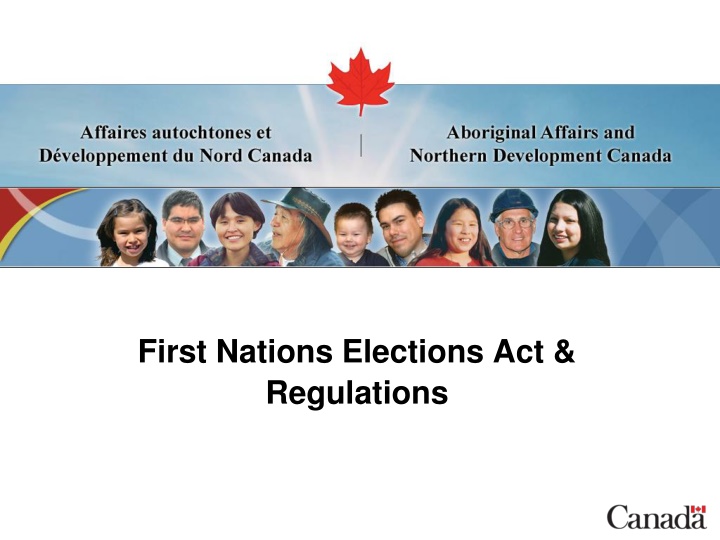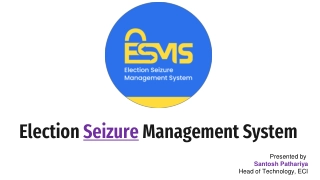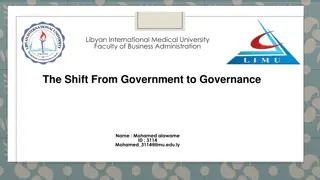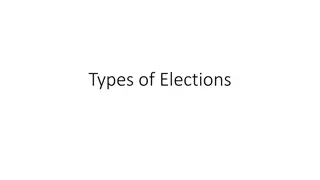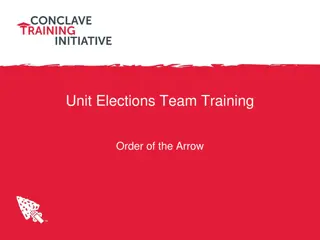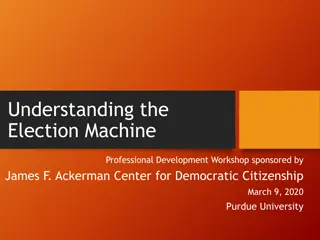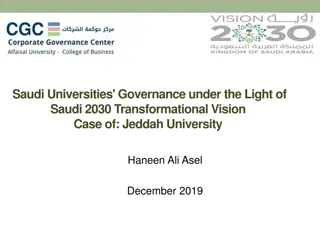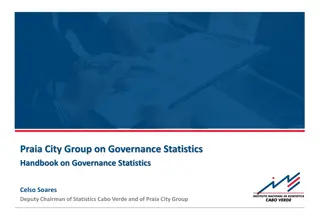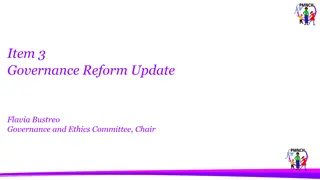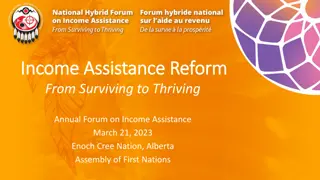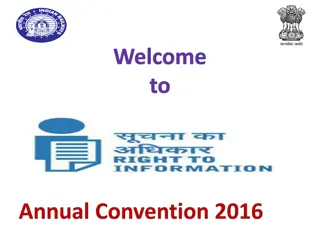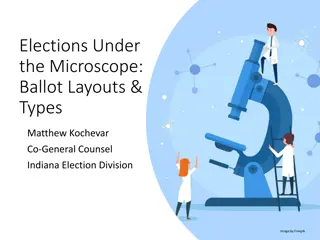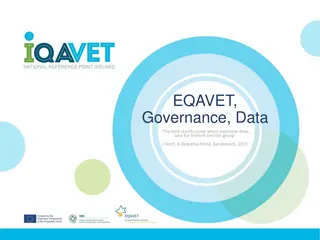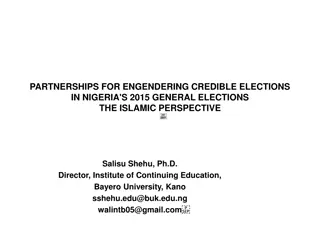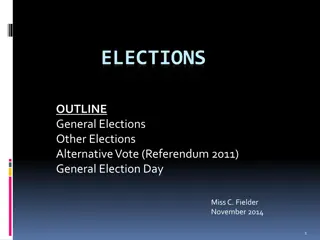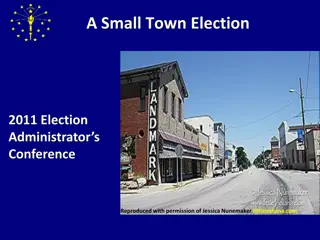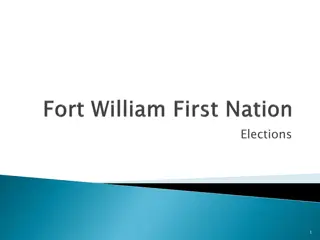Enhancing First Nations Governance through the First Nations Elections Act
The First Nations Elections Act (FNEA), developed between 2008 and 2011, addresses weaknesses in the Indian Act election system by offering an optional framework for First Nations governance. Key components include four-year terms, common election days, court appeals, defined offenses, and opting out with community election codes. FNEA aims to tackle issues like council instability, paternalistic appeal processes, and election fraud. First Nations can choose to opt into FNEA after community discussions. The Act provides a more robust and transparent electoral process for Indigenous governance.
Download Presentation

Please find below an Image/Link to download the presentation.
The content on the website is provided AS IS for your information and personal use only. It may not be sold, licensed, or shared on other websites without obtaining consent from the author.If you encounter any issues during the download, it is possible that the publisher has removed the file from their server.
You are allowed to download the files provided on this website for personal or commercial use, subject to the condition that they are used lawfully. All files are the property of their respective owners.
The content on the website is provided AS IS for your information and personal use only. It may not be sold, licensed, or shared on other websites without obtaining consent from the author.
E N D
Presentation Transcript
First Nations Elections Act & Regulations
Background Between 2008 and 2011, the Assembly of Manitoba Chiefs (AMC) and the Atlantic Policy Congress of First Nations Chiefs (APC) developed the policy foundation for the First Nations Elections Act (FNEA) in order to address the weaknesses in the Indian Act election system. Following a national engagement exercise , these organizations provided recommendations to the Minister of Aboriginal Affairs and Northern Development. These recommendations form the content of the optional First Nations Elections Act and First Nations Elections Regulations, which came into force on April 2, 2015. Aboriginal Affairs and Northern Development Canada has a module on its Internet site where information and links to the legislation and the regulations can be found. Go to: www.aadnc-aandc.gc.ca/elections 2
Key Components of FNEA The recommendations provided by the AMC and the APC form basis of FNEA: Optional framework where band councils request, by resolution, that the Minister add their names to the schedule of First Nations to which the Act will apply Terms of office of four years The ability for a minimum of six First Nations to line up their terms of office and hold elections on the same day ( a common election day ) Removal of the role of the Department and the Minister in election appeals, with this role shifting to the courts, as in municipal, provincial and federal elections Defined offences and penalties enabling charges to be laid and penalties to be imposed for fraudulent activity in connection with an election A framework under which a First Nation can opt-out of the legislation by developing its own community election code and submitting it to a community vote 3
Issues Addressed by FNEA Chronic instability in band councils caused by a short two-year term of office. The paternalistic election appeal process involving the Department which affords decision making powers to the Minister and to the Governor in Council. The lack of rigour in the process to nominate candidates that invites frivolous nominations that make for excessively long slates of candidates (sometimes over 100). A system vulnerable to abuse and fraudulent activities because of the absence of defined offences and associated penalties to act as a deterrent. 4
First Nations Moving to FNEA After having discussed the issue with community members, a band council will determine if the FNEA better suits the governance needs of the First Nation. If the decision is made to opt in to FNEA, the band council will adopt a resolution that requests that the Minister of Aboriginal Affairs and Northern Development add the First Nation to the schedule; and provides a desired first election date The Indian Act term of office will end on the date of the election, which is fixed in the order, regardless of whether it has been a full two years. The four year term of office begins the day following the election. Subsequent elections must be held within the period of 30 days before the end of term. 5
Key Changes in the Electoral Process Shorter election period 65 days Number of councillor positions on the band council is established by the 1 per 100 rule unless council reduces the number of positions by band council resolution Candidates must provide a written acceptance of their nomination, and the band council can set a candidate fee of no more than $250 Mail-in ballots are sent only when the elector has made a written application accompanied by identification On request of the Council, advance polls can be held on or off the reserve between the 10th and 5th day before the election Automatic recount is triggered when the difference between a winning candidate and a runner up is five or less 6
New Timeline 65 day process under the Regulations: Day 65: First Nation provides the voters list and list of addresses to the electoral officer Day 60: The notice of nomination meeting is posted and sent to off-reserve electors whose address has been provided Day 35: Nomination meeting Day 32 at 6 p.m.: Deadline to receive the declaration of candidacy and the fee if applicable Day 30: Mail-in ballot packages are sent to electors who have submitted an application along with their identification Day 6: Last day for the electoral officer to receive requests for mail-in ballots and to send them out Days 10 to 5: Potential advance polls Day 0: Election Day Day -1: Recount if necessary Day -30: Deadline to apply to the courts to contest the election (appeal) 7
Candidates Persons nominated and seconded do not automatically become candidates. They must sign a declaration accepting the nomination for only one position. A person cannot be a candidate for both a chief and councillor position at the same election. Nominees may complete the form and provide it to the electoral officer or the deputy electoral officer at the nomination meeting or can send it by e- mail or fax. The electoral officer must be in receipt of the Candidate s Declaration by 6 p.m. on the third day following the nomination meeting. If a person who has been nominated does not provided a Candidate Declaration to the electoral officer by the deadline, his or her name will not appear on the ballot. 8
Candidate Fee Under FNEA, the Council may by resolution impose a candidate fee of up to $250 on every candidate for chief or councillor, to be refunded if the candidate receives more than five per cent of the total votes cast. Nominees must pay the fee in cash or by certified cheque, money order or electronic transfer, and it must be received by the electoral officer or the deputy electoral officer by 6 p.m. on the third day following the nomination meeting (the same as the deadline for receipt of the Candidate s Declaration). Only nominees who have provided their signed Candidate s Declaration and their candidate fee (if applicable) by this deadline will become candidates. Within 30 days of the election, the electoral officer must return the candidate fee to all candidates who received more than 5% of the total votes cast. 9
Mail-in Ballots Mail-in ballots are distributed only on written request. Electoral officers will still obtain a list of addresses from the First Nation at the beginning of the election period, for the nomination mail out. The nomination mail out will now include an Application for Mail-in Ballot. The application may also be sent by e-mail or fax to an elector. Electors who wish to vote by mail-in ballot must complete the application and send it to the electoral officer by mail, fax or e-mail. along with a photocopy of an identification document, The identification document can be any official document that proves the identify of the elector, such as a status card, a drivers licence, a health card, a passport or a library card. Only upon receipt of the application and the identification document will the electoral officer send a mail-in ballot package. Applications must be received no later than the 6th day before the election. After this time, an elector can only vote in person at the advance poll (if there is one), or the polling station on the day of the election. 10
Advance Polls The First Nation council may ask that one or more advance polls be held. They can be held on or off the reserve. Advance polls can only be held between the 10th and 5th day before the election. If advance polls are to be held, this must be determined prior to the posting and mailing of the notice of nomination meeting, at least 60 days before the election. An elector who votes at an advance poll cannot vote on election day. Proceedings at advance polls are identical to proceedings at an election day poll, with the exception that, at the close of the poll, the ballot boxes are sealed and placed in safekeeping. The ballot boxes for advance polls will be counted at the same time as the election day ballot boxes. 11
Automatic Recount The regulations state that if the difference between the number of votes of a candidate who would otherwise be declared elected and another candidate for the same position is five or fewer, the electoral officer must conduct a recount. The electoral officer can decide to conduct the recount immediately, or announce a place and time for the recount, which must take place within 24 hours. If the recount is not to take place immediately, the ballots must be placed in envelopes, sealed and held in safekeeping. The electoral officer need only recount the ballots marked for the wining and runner-up candidates who are within five votes. After the recount, the electoral officer will announce the winning candidates. 12
Appeals An elector may appeal the election by application to the federal or provincial court on the grounds that there was a contravention of the Act or the regulations that is likely to have affected the result. The application must be filed within 30 days after the election. After hearing the application, the court may set aside the election. 13
Offences and Penalties The First Nations Elections Act provides several offences for which a person, found guilty by a court, can receive a fine or a jail term. In addition, certain offences carry an additional automatic penalty of not being eligible to be elected as chief or councillor during the five years after the date of conviction. The offences provided in FNEA are the same offences found in the Canada Elections Act and applicable to federal elections. These offences include activities surrounding vote buying, bribery, voting when not eligible, forging ballots and obstruction of the electoral process. 14
